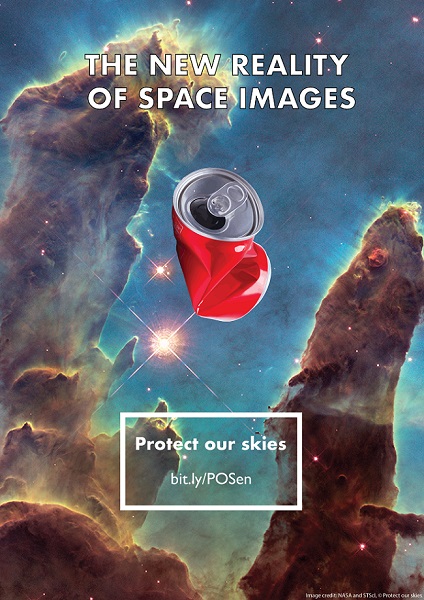Jonge sterrenkundigen vragen aandacht voor satellietvervuiling en ruimtepuin
Drie jonge, gepromoveerde astronomen die elkaar in Nederland hebben ontmoet, vragen aandacht voor lichtvervuilende satellietnetwerken en ruimtepuin. Ze hebben een website gemaakt met een interactieve infographic en zeven downloadbare posters. Hun campagne gaat vooraf aan de wereldwijde Satcon2-conferentie van half juli waar sterrenkundigen en satellietbouwers discussiëren over manieren om de storende invloed van satellieten te verminderen.
Particuliere telecommunicatiebedrijven zoals Starlink lanceren in rap tempo satellieten om zo bijvoorbeeld internet op ontoegankelijke plaatsten mogelijk te maken. Starlink heeft inmiddels een netwerk van meer dan 1600 satellieten rond de aarde en een vergunning voor 12.000. Amazon wil ook satellieten lanceren en China heeft ook plannen. Geschat wordt dat er binnen tien jaar tussen 50.000 en 100.000 nieuwe satellieten rond de aarde draaien. Dat is twintig keer zo veel als nu.
Met de campagne Protect our skies vragen drie jonge, gepromoveerde sterrenkundigen aandacht voor de schadelijke gevolgen van de satellietnetwerken. Het gaat om Kateryna Frantseva, sterrenkundige aan de Rijksuniversiteit Groningen, Jure Japelj (voorheen Universiteit van Amsterdam, nu freelance wetenschapscommunicator) en Martha Irene Saladino (voorheen Radboud Universiteit, nu wetenschapscommunicator aan de Universidad Diego Portales in Chili).
De astronomen maken zich zorgen over de negatieve gevolgen van de satellieten voor het astronomisch onderzoek. De satellieten verstoren de gevoelige waarnemingen van sterrenkundigen en gooien roet in het eten bij astrofotografen. Bedrijven lanceren inmiddels satellieten die minder licht weerkaatsen, maar dat is tot nu toe nog niet goed genoeg. Daarnaast wordt de kans op botsingen in de ruimte steeds groter. Daardoor kunnen weersatellieten uitvallen en navigatiesystemen en mobiele telefoons slechter werken.
Volgens de astronomen moeten er twee soorten regels komen. De eerste set regels gaat over hoe de satellieten eruitzien en dat ze bijvoorbeeld geen zonlicht reflecteren. De tweede set regels behandelt het verantwoordelijk omgaan met satellieten en ruimtepuin. Satellietbedrijven zouden bijvoorbeeld de banen van hun satellieten kunnen doorgeven aan sterrenkundigen zodat zij op tijd hun gevoelige camera's kunnen wegdraaien. En bedrijven of landen die satellieten de lucht in schieten, moeten ook zorgen dat ze weer netjes worden opgeruimd.

